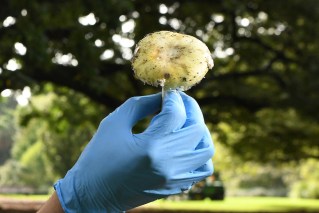‘Panic grass’ tumbleweed invades north-east Victoria

A home in north-east Victoria has been inundated by tumbleweed. Photo: ABC/Leanne Gloury
Tumbleweed is so out of control in a north-east Victorian town that a resident has been blocked from entering her home.
Native grass known as hairy panic, or witch grass, is in plague proportions in Laceby, south of Wangaratta, with residents battling the outbreak for the past seven weeks.
Leanne Gloury said the situation had gotten progressively worse.
“It hit its peak last Wednesday when it was up to my roof and I couldn’t get access to the front door,” she said.
A similar outbreak hit Wangaratta in 2016, when tumbleweed besieged about 20 houses at a new estate built next to farmland west of the town.
However, Ms Gloury said she had not seen anything as bad as the hairy panic at her property.
“Back in 2016, we didn’t cop it like this. This is the first time I’ve seen it this bad – it’s just out of control.”
Road struck by tumbleweed storm
When Ms Gloury posted images on social media of her home blanketed by tumbleweed, friends suggested she set the weed alight or adopt a goat to eat it.
She has since tried a range of less extreme solutions, without luck.

A Wangaratta house inundated by ‘hairy panic’. Photo: ABC/Leanne Gloury
“I went and bought a blower and that helped for a couple of days. I’ve raked, I’ve swept, I’ve even tried riding over it with the ride-on mower, but it just got stuck and blocked up the mower blades,” she said.
Wangaratta Mayor Ken Clarke said a road between Glenrowan and Milawa had been struck by a tumbleweed storm at the weekend.
Visibility on the road was so low council erected hazard signs and police controlled traffic.
Cr Clarke said he was not sure how many local houses had been consumed by hairy panic.
But he said the council had no official responsibility to help with the clean-up.
“It’s something that happens with weather conditions. It’s just an act of God,” he said.
“Unfortunately these people are in the wind direction and it’s gone to their place rather than mine.
“We’ll do everything we can to assist them, if they do want assistance.”
What is hairy panic?
There are more than 40 native and introduced species of hairy panic, or panicum, in Australia.
Plant and weed expert Leslie Weston, from Charles Sturt University, said the weed was well suited to Australia’s hot summers, and was found in over-grazed pastures and summer fallows.
Professor Weston’s research shows the introduced species has spread more quickly over the past decade, getting into South Australia, Victoria, New South Wales and Queensland.
She said Panicum hillmanii, found near north-east Victoria and the Riverina, was introduced from southern America.
It was developed as a grazing crop, but here we’ve found that panicum species are noxious weeds.
“They cause issues with livestock toxicity … resulting in irritation to ears, eyes on grazing sheep, cattle and horses, and also in some cases death.”
Professor Weston said herbicides, rotational grazing and careful disposal could help prevent the weed spreading further.
“As part of our projects, we’re looking at strategies. Because the weed is so widespread, we have to look at management on a wider scale.”








